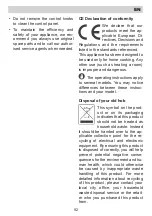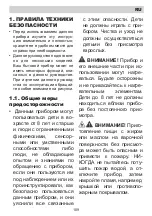
EN
103
trying chemical cleaning agents. This
is the ideal method for removing even
the smallest deposits from the hob, and
for removing spillages from hot cooking
zones before they burn onto the hob.
CAUTION:
Be careful when using
the spatula. Its blade can cause in-
juries!
If you use the spatula incorrectly,
the blade may break. If this hap-
pens, do not try to remove the piece with
your hands, use pliers or a knife with a
thin blade carefully. (See Fig. 1)
Use only the spatula blade on the
ceramic surface avoiding its body
coming into contact with the surface as it
may scratch it.
Use the spatula blade only if it is in
perfect condition. Replace the
blade immediately if its integrity is dam-
aged in any way.
Once you are done with the spatu-
la, retract the blade and lock it.
(See Fig. 2)
5. CLEANING AND
MAINTENANCE
5.1 Cleaning
WARNING:
Switch o
ff
the appli-
ance and allow it to cool before
cleaning is to be carried out.
General Instructions
• Check whether the cleaning materials
are appropriate and recommended by
the manufacturer before use on your
appliance.
• Use cream cleaners or liquid cleaners
which do not contain particles. Do
not use caustic (corrosive) creams,
abrasive cleaning powders, rough
wire wool or hard tools as they may
damage the hob surfaces.
Do not use cleaners that contain
particles, as they may scratch the
glass, enamelled and/or painted parts of
your appliance.
• Should any liquids over
fl
ow, clean
them immediately to avoid parts
becoming damaged.
Do not use steam cleaners for
cleaning any part of the appliance.
Cleaning the Ceramic Glass
Ceramic glass can hold heavy utensils
but may be broken if it is hit with a sharp
object.
WARNING:
Ceramic Cooktops - if
the surface is cracked, to avoid the
possibility of an electric shock, switch o
ff
the appliance and call for service.
• Use a cream or liquid cleaner to clean
the vitroceramic glass. Then, rinse and
dry them thoroughly with a dry cloth.
Use of spatula
Hidden blade
Extracted blade
Fig. 2
Fig. 1
















































